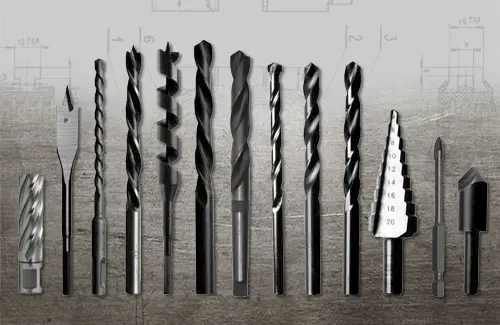The regular price is the current manufacturer's recommended price! FREE shipping for orders over EUR 41,67 within CZ+SK (PPLparcel)

In today's article, we will focus on the basic division of drills, because each type of drill is optimized for a specific use and material in order to achieve the best possible drilling result.
So how do we divide drills?
1. By shape (construction)
◦ Spiral/cylindrical drill - the most commonly used drill for ordinary cylindrical holes, which you will certainly find in every workshop. It has different tip angles.
◦ Stepped drill ("tree") - for drilling various diameters in sheet metal and thin materials
◦ Double-ended drill (coachbuilder's) - with a short helix with a self-centering blade recommended for drilling into thin-walled materials.
◦ Hole saw - fast and clean drilling without vibrations, ideal for heating engineers, electricians, etc.
◦ Core drill - for easy and fast drilling of holes in steel structures and hard-to-reach places, for magnetic drills.
◦ Center drill/spotting drill - suitable for making holes for fixed and rotating tips, when centering precisely placed holes.
◦ Tenon plug cutter/Forstner drill - for making wooden plugs for repairing knots and imperfect wooden parts.
2. According to the type of material processed
◦ Metal drill bits - specific cutting edge geometry, different cutting angles. The best patented metal drill bits - CZ002 and CZ004.
◦ Wood drill bits - usually with a centering tip (e.g. auger bits, spiral with a CZ50 helix, knot removers/Forstner drill bits...).
◦ Concrete and masonry drill bits - mostly two- or four-edged with carbide tips.
◦ Glass and ceramic drill bits - for drilling brittle and hard materials (glass, porcelain, tiles, mirrors). These include, for example, slice drill bits or diamond crowns.
◦ Auger drill bits - for drilling rock during construction or gardening.
◦ Universal drill bits - in our offer known as UNI drill bits - are a combination of the above types and can be used in various types of materials.
3. By type of clamping
◦ With a cylindrical shank - the most common type of clamping.
◦ With a conical shank (Morse taper) - mostly used in industry and on lathes.
◦ With a hexagonal shank - for cordless screwdrivers.
◦ With a 3D shank - with three flats - a revolutionary 3D shank that prevents rotation in the chuck.
◦ With SDS shank - most commonly SDS-Plus or SDS-Max for hammers and rotary hammers.
◦ With Weldon clamping - for milling
4. By the material of drill body
◦ HSS (high-speed steel) - most commonly used for metalworking
◦ HSS-Co (with cobalt, most often 5-8%) - most commonly used for machining harder materials (e.g. stainless steel)
◦ Carbide - the highest quality material for machining very hard materials
◦ Indexable insert drills - durable drills that last a very long time
The company NÁSTROJE CZ, s.r.o. is a Czech manufacturer of drills and offers most of the mentioned tools!